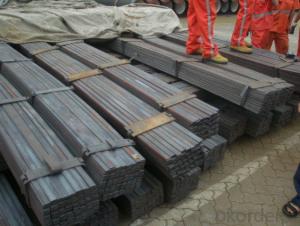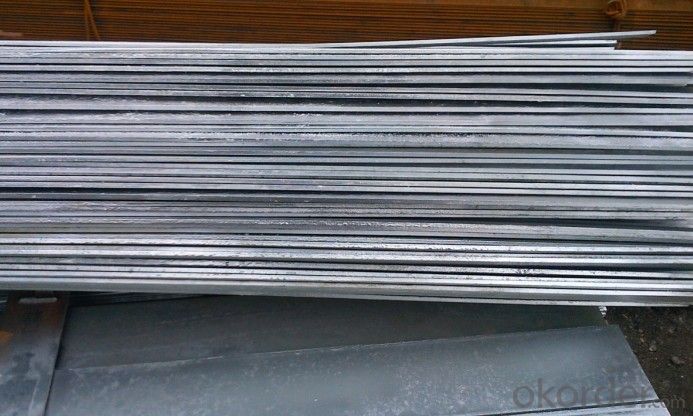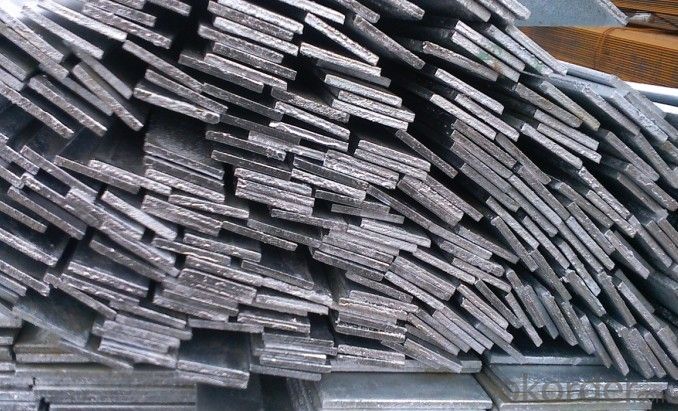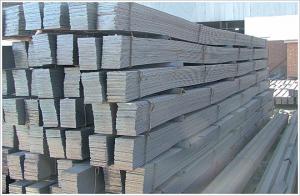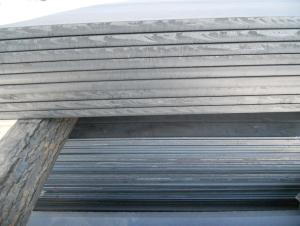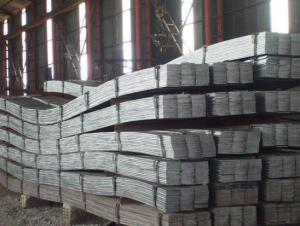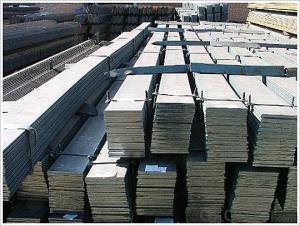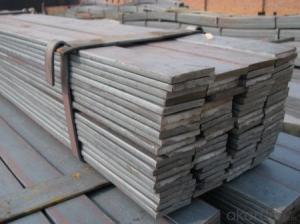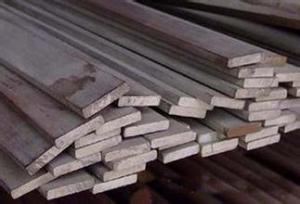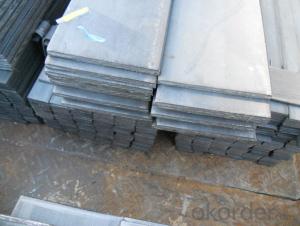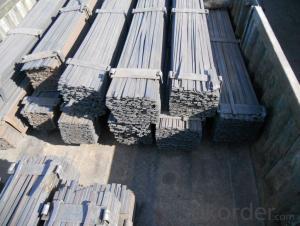Steel Flat Bar with High Quality for Construction
- Loading Port:
- China main port
- Payment Terms:
- TT or LC
- Min Order Qty:
- 25 m.t.
- Supply Capability:
- 10000 m.t./month
OKorder Service Pledge
OKorder Financial Service
You Might Also Like
Specification of Steel Flat Bar with High Quality for Construction:
Commodity: Hot Rolled Steel Flat Bar
Standard: GB;JIS
Material: Q195-Q235
Brand name: FLATSPACE
Origin place: China
Thickness: 3mm-30mm
Width:20mm-200mm
Length: Max 12m
Certification: SGS/BV
Usage/Applications of Steel Flat Bar with High Quality for Construction:
Widely used for construction, Machinery manufacturing, Iron tower steel structure, Shipbuilding; Steel grating, Staircase, Bridge, Viaduct, Railway spare parts, Boilers making etc.
Production Flow of Steel Flat Bar with High Quality for Construction:
The steel flat bar is made through three processes:
1.Feeding the material: Feeding the row material (the steel plate) to Slitting Line.
2.Slitting:The steel plate would be slitted into expected width by lengthways cutter.
3. Leveled and cutting: The plat bar would be ground into level by the grinder and then cut into required length.
Packaging & Delivery of Steel Flat Bar with High Quality for Construction:
1.Packaging Details: The Steel Flat Bars are packed in bundles and loaded in 20 feet/40 feet container, or shipped by bulk cargo ,also we can do as customer's requirements.
2.Delivery Details:30~45 days upon the receipt of buyer payment by T.T. or L/C.
3. Marks:
Color marking: There will be color marking on both end of the bundle for the cargo delivered by bulk vessel. That makes it easily to distinguish at the destination port.
Tag mark: there will be tag mark tied up on the bundles. The information usually including supplier logo and name, product name, made in China, shipping marks and other information request by the customer.
If loading by container the marking is not needed, but we will prepare it as customer requests.
FAQ:
Q1: Why buy Materials & Equipment from OKorder.com?
A1: All products offered byOKorder.com are carefully selected from China's most reliable manufacturing enterprises. Through its ISO certifications, OKorder.com adheres to the highest standards and a commitment to supply chain safety and customer satisfaction.
Q2: How do we guarantee the quality of our products?
A2: We have established an advanced quality management system which conducts strict quality tests at every step, from raw materials to the final product. At the same time, we provide extensive follow-up service assurances as required.
Q3: How soon can we receive the product after purchase?
A3: Within three days of placing an order, we will begin production. The specific shipping date is dependent upon international and government factors, but is typically 7 to 10 workdays.
Images:
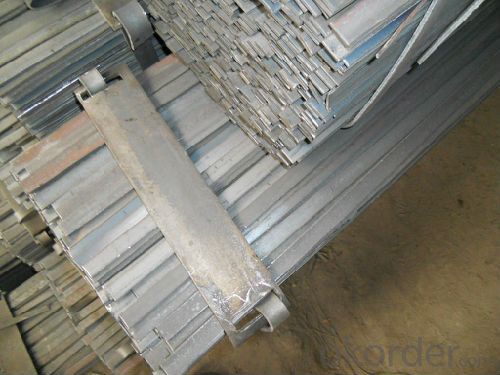
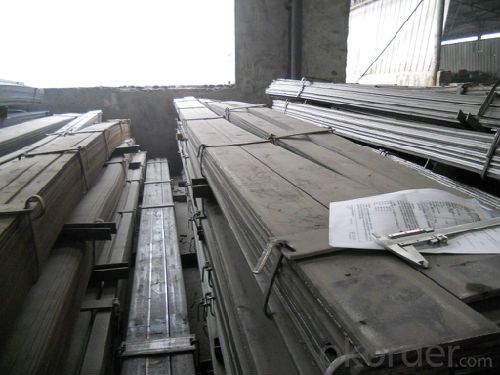
- Q: Can steel flat bars be used for making stair treads or steps?
- Yes, steel flat bars can be used for making stair treads or steps. Steel flat bars are strong and durable, making them suitable for supporting weight and providing stability. They can be welded or bolted together to create a sturdy structure for stair treads or steps. Additionally, steel flat bars can be easily customized and shaped to fit specific design requirements.
- Q: Can steel flat bars be used for making brackets or supports for audio/video equipment?
- Indeed, brackets or supports for audio/video equipment can be fashioned using steel flat bars. Steel, being a robust and resilient material, is well-suited for the task of supporting bulky equipment. The flat configuration of the bars permits effortless fastening to walls, ceilings, or other surfaces. Furthermore, steel flat bars can be readily cut and molded to match the precise dimensions and specifications of the equipment. They offer stability and are capable of enduring the weight and strain of audio/video equipment, guaranteeing a secure and protected installation.
- Q: What are the different types of surface defects in brass steel flat bars?
- There are various types of surface defects that can be found on brass steel flat bars, which can occur during the manufacturing, processing, or handling of the material. Some common surface defects in brass steel flat bars include the following: 1. Scratches: Shallow marks or abrasions on the surface of the flat bar that can be caused by mishandling, contact with sharp objects, or improper storage. These scratches can affect the bar's appearance and potentially weaken its structural integrity. 2. Pitting: Small, localized cavities or depressions on the surface of the flat bar. Pitting can occur due to exposure to corrosive environments or chemical reactions. It can compromise the smoothness of the surface and may lead to further corrosion if not treated. 3. Rust or corrosion: When exposed to moisture, humidity, or aggressive chemicals, brass steel flat bars can develop rust or corrosion. Rust appears as a reddish-brown coating on the surface and can weaken the bar over time. Corrosion can also result in pitting or flaking of the surface. 4. Dents or dings: Small deformations or indentations on the surface of the flat bar. These defects can occur during handling or transportation, especially if the bars are not adequately protected. While dents may not significantly impact the structural integrity, they can affect the overall appearance. 5. Roll marks: Surface imperfections that occur during the rolling process used to shape the brass steel flat bars. These marks can appear as ridges, depressions, or patterns on the surface. Although they may not affect the functionality of the bar, they can impact its aesthetic appeal. 6. Scale: The layer of oxides that forms on the surface of brass steel flat bars during heating or high-temperature processes. Scale appears as a thin, flaky coating that can be easily removed mechanically. While scale does not affect the structural integrity, it can impact the surface finish. It is important to understand that the severity of surface defects can vary, and the acceptability of certain defects depends on the specific application or industry standards. Regular inspection, proper handling, and appropriate surface treatment methods can help mitigate and prevent these surface defects in brass steel flat bars.
- Q: Are steel flat bars suitable for making conveyor systems?
- Certainly! Steel flat bars are indeed a fitting choice for the construction of conveyor systems. Renowned for their robustness, longevity, and capacity to bear substantial burdens, steel flat bars possess indispensable attributes for conveyor systems. They furnish a steadfast and secure foundation for the transportation of materials, effectively enduring the ceaseless motion and forceful impacts demanded by conveyor systems. Furthermore, steel flat bars can be effortlessly crafted and tailored to match the precise dimensions and contours required for the conveyor system. All in all, steel flat bars constitute a dependable and extensively employed material for the assembly of conveyor systems across diverse industries.
- Q: What are the different manufacturing processes for steel flat bars?
- Producing steel flat bars involves several manufacturing processes, which vary depending on the desired specifications and requirements of the final product. Commonly used processes for steel flat bars include hot rolling, cold rolling, shearing, slitting, laser cutting, and saw cutting. Hot rolling is the most widely used method. It involves heating a large steel slab, passing it through rollers to reduce thickness and shape it into a flat bar, and then cooling and cutting it to the desired length. Cold rolling, on the other hand, involves heating the steel and passing it through rollers at room temperature to improve surface finish and dimensional accuracy. Shearing is a cutting process used for smaller quantities or specific dimensions. It involves cutting large steel plates or sheets into smaller flat bars using a shearing machine. Slitting is similar to shearing, but it involves cutting wide steel coils into narrower strips, which are then rolled into flat bars. This process is commonly used for precise dimensions. Laser cutting is a modern and precise method. It uses a high-powered laser beam to melt or vaporize the steel, creating a clean and accurate cut. Laser cutting is often used for complex shapes and specialized applications. Saw cutting involves using a saw blade to cut through the steel and produce flat bars. It is commonly used for cutting large steel sections or when a specific length is required. These are just a few examples of the manufacturing processes used for steel flat bars. The choice of method depends on factors such as desired dimensions, tolerances, surface finish, and production volume. Each process has its advantages and limitations.
- Q: What is the thickness deviation of 40*4 galvanized flat steel?
- 40 is the width of the section steel, 4 is the thickness of the steel, and the unit is mm.Flat, refers to the width 12-300mm, thickness 4-60mm, cross section is rectangular in shape and with a blunt edge of steel. Flat steel can be finished steel, or can be used as the blank of welded pipe and thin slab for laminated sheet rolling.
- Q: What is the weight of a steel flat bar?
- The weight of a steel flat bar changes as its dimensions, such as length, width, and thickness, differ. In order to calculate the weight accurately, the precise measurements of the flat bar must be known. Steel possesses a density of around 7.85 grams per cubic centimeter. Thus, after obtaining the dimensions, one can determine the weight by multiplying the bar's volume by the density.
- Q: Why do some buildings need a steel bar around the top?
- Galvanized flat steel can be used to produce iron, tools and mechanical parts, and is used as frame structures and escalators for buildings.Flat steel adopts negative deviation rolling, but according to actual weight delivery, the utilization ratio of steel plate increased by -5 percentage points. Flat can according to user needs, set the thickness, width and length of production, for the user to reduce the cut and save processes, reducing labor, material consumption, but also reduce the loss of raw materials processing, time saving, material saving. Products have been specialized in steel structure manufacturing, machinery manufacturing, automotive industry, mining machinery, lifting machinery and other industrial materials.
- Q: What is the representation of flat steel?
- Flat steel can be finished steel, or can be used as the blank of welded pipe and thin slab for laminated sheet rolling. Main application: flat steel is used as a material, used for making iron, tools and machinery parts, and used as frame structures and escalators for buildings.
- Q: Can steel flat bars be used for making sculptures?
- Yes, steel flat bars can certainly be used for making sculptures. Steel is a versatile and durable material that allows for various artistic expressions. Flat bars provide a solid base and can be easily manipulated and welded to create different shapes and forms. Additionally, steel flat bars can be cut, bent, and shaped to create intricate details and textures in sculptures. Their strength and stability make them suitable for both indoor and outdoor sculptures, as they can withstand different weather conditions. Overall, steel flat bars are a popular choice among sculptors for their versatility and ability to bring artistic visions to life.
Send your message to us
Steel Flat Bar with High Quality for Construction
- Loading Port:
- China main port
- Payment Terms:
- TT or LC
- Min Order Qty:
- 25 m.t.
- Supply Capability:
- 10000 m.t./month
OKorder Service Pledge
OKorder Financial Service
Similar products
Hot products
Hot Searches
Related keywords
